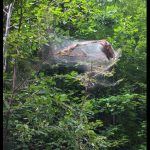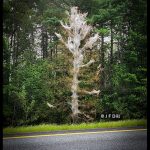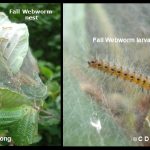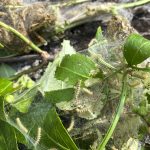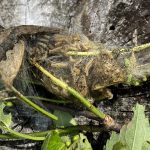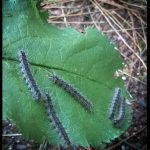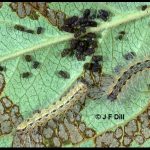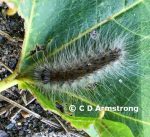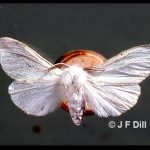Fall Webworm
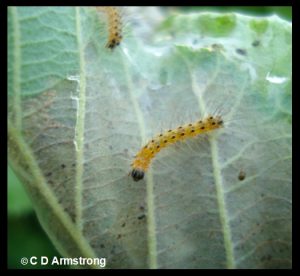
The Fall Webworm (Hyphantria cunea), is a type of moth larva in the family Arctiidae which makes a communal webbed nest in the limbs of a wide variety of hardwood trees such as alder, apple, ash, cherry, willow, oak, birch, box elder (boxelder maple), elm, elderberry, hickory, mulberry, poplar, walnut and other deciduous species in the late summer and fall. In Maine, they may also be found on highbush blueberries, cannabis and hops.
Not to be confused with the more destructive Eastern Tent Caterpillar or the dreaded Browntail caterpillars, fall webworm caterpillars show up much later in the season (approximately mid-July), well past the point when the eastern tent and browntail caterpillars have already pupated and turned into moths. Fall webworm is more of an aesthetic pest by virtue of their nests and the fact that the larvae are not believed to harm otherwise healthy ‘wild’ trees since the bulk of the leaf consumption occurs just prior to the natural leaf drop by the trees. However, the feeding by the caterpillars can be damaging to ornamental trees.
Fall Webworm Moth (Adult Stage) Potential Lookalikes:
- Browntail Moth: Fall webworm populations found in Maine and other northern portions of its range have wings that are sometimes solid white so people have been fooled into thinking they were Browntail moths (as in the specimen pictured below or like with these two examples from BugGuide: Example 1 and Example 2) instead of having brown spots and patches all over them as many of them do, especially as one heads south through their range (Spotted Form of the Fall Webworm Moth). Also, fall webworm moths appear in Maine earlier than browntail moths appear (end of May and early June as opposed to July, respectively).
- Virginian Tiger Moth — A similar white moth occurring at the same time in Maine but with two distinctive black dots near the base of each wing, and no brown on the abdomen) (BugGuide.net)
- Fall Webworm nest in Populus grandidentata (white poplar/American aspen/Big-tooth aspen) (Etna, ME; 7/31/2024)
- Tree covered in webbing from Fall Webworm (Palmyra, ME; 8/27/2024)
- Fall Webworm (nest and larva)
- Part of a nest of Fall Webworm caterpillars on an elderberry (Naples, ME; 7/15/2024) (Photo courtesy of M. Shepard)
- Nest of Fall Webworm caterpillars on an elderberry (Naples, ME; 7/15/2024) (Photo courtesy of M. Shepard)
- Fall Webworm caterpillars on an apple leaf (Etna, ME; 8/1/2024) (the physical appearance of these caterpillars changes a lot as they mature)
- Pair of Fall Webworm caterpillars feeding on a crabapple leaf
- A mature Fall Webworm larva (Farmington, ME; 9/5/2020)
- Fall Webworm Moth (see also an example of the spotted form of the fall webworm moth)
Additional Information:
- Fall Webworm (Maine Forest Service)
- Fall Webworm (Penn State)
- Fall Webworm (University of Florida)
- Fall Webworm (BugGuide.net)

